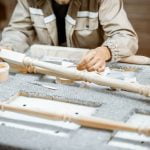What is a woodworkers bench? A woodworkers bench is an essential piece of equipment for anyone who works with wood.
Whether you are a professional carpenter or an amateur hobbyist, a sturdy and well-built woodworkers bench can make all the difference in your woodworking projects. In this article, we will explore the history and evolution of woodworkers benches, the key components of a woodworkers bench, different types and their uses, the importance of a sturdy and well-built woodworkers bench, how to choose the right one for your needs, as well as tips for maintaining and caring for it.
The woodworkers bench has been a staple in workshops for centuries, evolving alongside the craft of woodworking itself. From its origins as a simple surface for sawing and planing wood to intricate designs with clamps, vises, and storage compartments, the woodworkers bench has come a long way. Understanding its history and evolution can provide valuable insight into its significance in woodworking today.
As we delve deeper into this topic, we will also discuss the key components that make up a woodworkers bench. Understanding these components can help you identify what makes a good quality bench versus one that may not meet your needs as effectively. We will also explore the different types of benches available and their specific uses, ensuring that you can choose the right one for your particular woodworking projects.
The History and Evolution of Woodworkers Benches
Woodworking has been a part of human history for centuries, and the woodworkers bench has played an integral role in this craft. The history and evolution of woodworkers benches can be traced back to ancient civilizations where craftsmen would fashion simple workbenches as platforms for shaping and crafting wood. These early iterations were typically basic in design, consisting of little more than a sturdy surface and perhaps a vise or clamping mechanism.
Medieval Era and Renaissance
During the medieval era and Renaissance period, woodworking as a trade began to flourish, leading to the development of more sophisticated woodworkers benches. Craftsmen recognized the need for specialized workbenches that could accommodate different woodworking tasks. This led to the introduction of features such as tool storage, adjustable work surfaces, and integrated clamping systems.
Industrial Revolution
The Industrial Revolution marked a significant shift in the production of woodworkers benches. With advancements in manufacturing technology, mass-produced workbenches became more accessible to woodworking enthusiasts. This period also saw the rise of specialized benches for specific woodworking disciplines such as joinery, cabinetry, and carving.
As time has progressed, modern innovations continue to shape the design and functionality of woodworkers benches, ensuring that they remain essential tools for woodworkers of all skill levels. Today’s woodworkers benches are available in a variety of styles and configurations, utilizing materials like hardwoods, steel, and even hybrid designs that combine traditional craftsmanship with modern engineering techniques.
The Key Components of a Woodworkers Bench
A woodworking bench is an essential piece of equipment for anyone working with wood. It provides a sturdy and stable surface for a woodworker to craft and create their projects. The key components of a woodworking bench are crucial to its function and usefulness in the workshop.
The main components of a woodworkers bench include:
- Workbench Top: This is the flat surface of the bench where the woodworking takes place. It should be made of a sturdy, durable material such as hardwood or laminated maple.
- Vises: Woodworking benches often come equipped with vises that can hold pieces of wood in place while they are being worked on. They are usually located at one end of the workbench.
- Tool Well: Some woodworking benches feature a tool well, which is essentially a tray or depression in the workbench top for holding tools and other small items.
- Bench Dogs: These are small pegs that can be inserted into holes in the workbench to help secure pieces of wood in place.
It’s important for woodworkers to understand the key components of a woodworking bench in order to choose the right one for their specific needs and projects. The features and functionality of each component will vary depending on the type and style of woodworking being done. Whether it’s hand tool woodworking, power tool woodworking, or a combination of both, having a solid understanding of what makes up a quality woodworking bench is crucial for any dedicated craftsman.
Types of Woodworkers Benches and Their Uses
Woodworkers benches come in a variety of styles, each serving different purposes and catering to the specific needs of woodworkers. Understanding the types of woodworkers benches and their uses can help you choose the right one for your woodworking projects.
Traditional Woodworkers Bench
The traditional woodworkers bench is typically made from hardwood such as beech or maple, and features a thick, sturdy top that can withstand heavy use. It often has a front vise, end vise, and bench dogs for holding workpieces in place. This type of bench is well-suited for hand tool woodworking, joinery, and other fine woodworking tasks.
European-Style Workbench
European-style workbenches are often longer and wider than traditional benches, providing ample workspace for larger projects. They feature a thick top with dog holes for clamping workpieces, as well as multiple vises for securing materials. This type of bench is commonly used by cabinetmakers, instrument makers, and those who work with large pieces of wood.
Cabinetmaker’s Bench
Cabinetmaker’s benches are designed to accommodate the unique needs of cabinetmaking and furniture making. They often include storage compartments, sliding trays, and built-in tool racks to keep tools and materials organized. These benches are ideal for woodworkers who require easy access to their tools and need a highly functional workspace.
By understanding the different types of woodworkers benches and their uses, you can choose a bench that best suits your individual woodworking needs. Whether you prioritize stability for hand tool work or require ample space for larger projects, there is a woodworkers bench designed to meet your requirements.
The Importance of a Sturdy and Well-Built Woodworkers Bench
A sturdy and well-built woodworkers bench is an essential piece of equipment for any woodworking enthusiast. The primary purpose of a woodworkers bench is to provide a stable and reliable work surface for various woodworking tasks. It is designed to withstand the rigors of cutting, shaping, and assembling wood, making it an indispensable tool in any woodworking workshop.
One of the most important aspects of a woodworkers bench is its stability. A sturdy bench provides a solid foundation for woodworking activities, ensuring that the workpiece remains secure and steady during use. This stability is crucial for achieving accurate and precise cuts, joinery, and other woodworking techniques. Additionally, a well-built bench can also absorb vibrations and shocks, further enhancing its stability during use.
Another key component of a woodworkers bench is its work-holding features. Many benches are equipped with vises, clamps, and holdfasts that allow woodworkers to secure their workpieces firmly in place while working on them. This not only improves safety but also enhances the accuracy and quality of the finished product. The ability to hold a workpiece securely can make all the difference in achieving professional-level results in woodworking projects.
In summary, a sturdy and well-built woodworkers bench is an indispensable tool for any woodworking enthusiast. Its stability and work-holding capabilities are essential for achieving precision, accuracy, and safety in various woodworking tasks.
| Importance of Woodworker Bench | Details |
|---|---|
| Stability | Provides a stable work surface for woodworking activities |
| Work-Holding Features | Equipped with vises, clamps, and holdfasts for securing workpieces |
How to Choose the Right Woodworkers Bench for Your Needs
When it comes to choosing the right woodworkers bench for your needs, there are several important factors to consider. The first thing to think about is the type of woodworking projects you will be working on.
For example, if you primarily work on larger pieces of wood, you will need a bench with a larger work surface and sturdy construction. On the other hand, if you mainly work on smaller, more intricate projects, a smaller bench with fine-tuned adjustments may be more suitable.
Another important consideration is the material of the woodworkers bench. Traditionally, these benches are made of hardwoods like maple or beech for their durability and stability. However, there are also options made from steel or other materials for specific woodworking needs. It’s essential to choose a material that can withstand the wear and tear of your woodworking projects.
The vise system is another critical component to consider when choosing a woodworkers bench. The vise allows you to secure your workpiece firmly in place while you’re working on it. There are various types of vise systems available, such as front vises, tail vises, or shoulder vises. Each type has its advantages depending on the kind of woodworking tasks you undertake. It’s essential to select a bench with a vise system that accommodates your specific needs and preferences.
| Woodworker’s Bench Feature | Description |
|---|---|
| Work Surface Size | Consider the size needed for your woodworking projects |
| Material | Choose between hardwoods like maple or beech, steel, or other materials based on project demands |
| Vise System | Select a vise system that meets your specific needs and preferences |
Tips for Maintaining and Caring for a Woodworkers Bench
A woodworker’s bench is a specialized piece of furniture designed for woodworking tasks. It typically features a flat surface that can withstand heavy pounding and has various mechanisms for holding the work in place, such as vises and dog holes. Maintaining and caring for a woodworker’s bench is crucial to ensure its longevity and optimal performance. Here are some tips for keeping your woodworker’s bench in top condition:
1. Regular Cleaning: To keep your woodworker’s bench in good shape, it is essential to regularly clean it from any sawdust, dirt, or debris that may accumulate during woodworking projects. Use a brush or vacuum to remove any particles from the surface and crevices of the bench.
2. Lubrication: The moving parts of a woodworker’s bench, such as the vises and screws, should be regularly lubricated to prevent rusting and ensure smooth operation. Use a high-quality lubricant to keep these components well-maintained.
3. Inspection and Repair: Periodically inspect the components of your woodworker’s bench for any signs of wear or damage. Check for loose screws, cracks in the surface, or any other issues that may affect its functionality. Promptly address any issues by making necessary repairs or replacements.
4. Protecting the Surface: The surface of a woodworker’s bench is often subject to heavy use and abuse. Consider using sacrificial boards to protect the bench when chiseling, sawing, or hammering on its surface.
By following these maintenance tips, you can ensure that your woodworker’s bench remains in excellent condition and continues to serve you well for many years to come.
The Future of Woodworkers Benches and Modern Innovations
In conclusion, the woodworkers bench has a rich history and has evolved over time to meet the changing needs of craftsmen. From its humble beginnings as a simple work surface, the modern woodworkers bench now incorporates various features and innovations that make woodworking tasks more efficient and enjoyable. Whether it is a traditional European-style workbench or a modern hybrid design, woodworkers benches continue to play an essential role in the craft of woodworking.
As technology continues to advance, we can expect to see even more modern innovations in woodworkers benches. This could include features such as built-in power outlets, integrated dust collection systems, adjustable height mechanisms, and more. These advancements will not only make woodworking tasks easier but also help woodworkers save time and effort on their projects.
Ultimately, the future of woodworkers benches looks promising as they continue to be an indispensable tool for anyone passionate about woodworking. As new technologies and design concepts are integrated into these essential workstations, woodworkers at all skill levels will have access to tools that enhance their craft and make woodworking an even more fulfilling experience.
Frequently Asked Questions
What Is the Woodworkers Bench Used For?
The woodworker’s bench is a specialized work surface used for woodworking projects. It provides a sturdy and flat platform for cutting, shaping, assembling, and finishing wood. It often includes features like vises, clamps, built-in tool storage, and dog holes to hold workpieces in place while they are being worked on.
What Is a Bench in a Workshop?
In a workshop, a bench is typically a work surface used for various tasks such as cutting, drilling, sanding, assembling, and finishing projects. It can be made of various materials like wood, metal, or composite materials and may have added features like vices or clamps to secure the workpiece during these tasks.
What Are the Best Features of a Woodworking Bench?
Some of the best features of a woodworking bench include a durable and flat work surface made from hardwood like maple or beech. Additional features such as vises with smooth operating mechanisms to hold the workpiece securely are also important.
Ample storage for tools and accessories within easy reach of the work area can also greatly enhance the functionality of a woodworking bench. Finally, having stable legs with levelers to accommodate uneven floors can make the bench more versatile in different workshop environments.

Hi everyone! I’m a woodworker and blogger, and this is my woodworking blog. In my blog, I share tips and tricks for woodworkers of all skill levels, as well as project ideas that you can try yourself.





